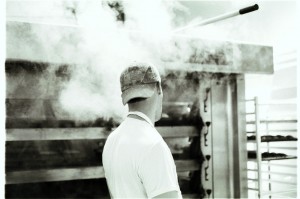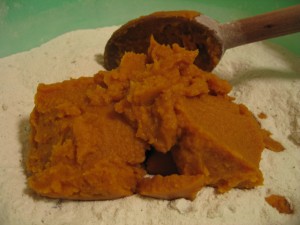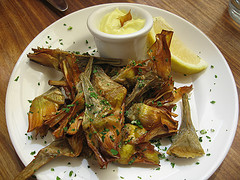Baking is a dying art. But making your own bread and cakes is sociable, satisfying – and surprisingly simple. Here, Jonathan Brown shares his story about a wonderful bakery in England named Betty’s Craft Bakery.
There is more than an hour to go until dawn and the rest of the world may be safely slumbering in its bed but I’m putting on a hair net and slipping into my baker’s whites. As someone whose previous forays into the world of flour and yeast have ended up with little to show other than something resembling a crispy cowpat, and a kitchen that looks like the aftermath of a shoot up in a Medellin cocaine factory, I’m approaching the day ahead with trepidation.
Arriving at Betty’s Craft Bakery, a vast Swiss chalet on an industrial estate near Harrogate in Yorkshire, England - the design is a tribute to the company’s founding father the confectioner-entrepreneur Fritz Butzer – the first thing I learn is that the real bakers here have already been hard at work for several hours, turning out hundreds of hot loaves, fresh cakes and some impossibly ornate pastries.
For me, the object of today’s lesson is to somehow overcome the irrational fear that bubbles up any time I reach for the dried fruit or desiccated coconut. Not that I mind cooking, far from it. Like most modern-day metrosexual men I pride myself on the fact that I can knock up a court bouillon and poach a Hebridean wild turbot with the best of them. But when it comes to folding together a bowl of cake mix, I confess I’m far more Mr Bean than Mr Kipling.
But it seems I am not alone. You may or may not be aware but it is UK National Baking Week – seven days of events designed to convince people like me that not only is making your own cakes and bread fun, it is also healthy and cheap – the perfect answer for those looking for good wholesome food in these economically straitened times.
It is estimated that half a century ago 90% of households would bake at least once a week. Today it is less than half that. According to celebrity chef Rosemary Shrager, who is the public face of this industry-backed campaign, the retreat from the range is a profound loss. “People have been persuaded by the food manufacturers and the supermarkets that they don’t have the time and that they are far too busy to bake and must buy convenience food instead. They think baked food is fattening and unhealthy but it is the complete opposite of that. You need to make time, get the children involved – baking is very social – everything they say against it is wrong and I feel that very strongly,” she says.
Having watched Hell’s Kitchen maybe once too often, I am expecting the atmosphere in the craft bakery to be a little intimidating. The reality could not be more different. While people are busy and clearly working extremely hard, relations are highly cordial. Betty’s commands a devoted loyalty from its staff. Many arrive fresh-faced from college, before honing their craft here their entire careers. It is a father to son, mother to daughter kind of place. You will even find spouses working alongside each other.
Here is perhaps evidence of the much vaunted psychological benefits attributed to baking. It is claimed that the mere process of kneading dough can expunge stress from the system. The smell of a freshly-baked cake percolating through a house is enough to lift even the blackest of moods while the process of moulding and shaping taps into our inner creativity.
Joining the bread station – the 11 bakers here have more than 150 years service between them – I am helping make the last batch of the day. But far from reaping any immediate existential dividends from fashioning the olive and sun-dried tomato rolls bound for the famous tea rooms across God’s own county, I am more concerned about the integrity of my dough matrix and keeping the embryonic loaflets the right way up. Perhaps I am over worrying. The bakery motto is “variation is a sign that craftsmen are in control”. Variation – yes, control – maybe not yet.
It takes up to five years of kneading and mixing before someone can call themselves a master baker. I am not that ambitious but I would like to be able to make bread once in a while.
David Smith, who has been rising at an unfeasibly early hour to turn out Yorkshire cobbles - a local round crusty style of bread loaf - to a grateful public for more than 20 years has some advice for me. “If you get given a bread maker – throw it in the bin or give it to a car boot sale. The mixing is fine but it comes out like a brick and it takes all the fun out of it. On a Sunday morning when you have nothing else to do you can make all sorts of things – chuck in whatever you like to the mix – sweet or savoury, just have a bit of fun. And if it gets too sloppy just keep on kneading – don’t add extra flour and you’ll see it change from a stringy mess to a lovely silky dough,” he says. Gary Rhodes, the British TV chef, apparently does a very good packet mix – nothing to be ashamed of, he tells me.
Since starting aged 15 in a small family-run business in Bradford, England, he has watched other bakers steadily shut down their ovens. “There used to be a time when every village had a baker but they have all gone now and that is down to supermarkets,” says Smith. He was forced to join the dark side himself but it was not a happy experience. “It was soul-destroying,” he recalls. “I wanted to come back and use my hands. It was about getting back to basics – doing it the way your grandfather and their grandfather did it.”
But for once the supermarkets have someone else to blame. It was Otto Frederick Rohwedder who installed the world’s first bread slicing machine at his bakery in Chillicothe, Missouri, back in 1928, later perfecting an automated way of wrapping the loaf. It was the beginning of the end for bread-making traditions that could be traced back to the ancient Egyptians, who became the first people to leaven the simple grain paste cakes that had been the stuff of life since Neolithic times. The simple alchemy of bread making has entranced mankind ever since. The rising process is brought about by the action of CO2 produced by the fermenting yeast trapped in the dough mixture. The cooking process kills off the yeast while the starches in the flour set hard to maintain the airy structure.
But there is more to baking than just bread. Next it is my turn making cakes. Here, pastry maker Sarah Lancaster is busy crumbing-up a giant vat of ‘fat rascal’ mix – a heavily guarded secret at Betty’s. Baking, Lancaster says, is an exact science, and soon I am measuring flour, sugar and dried fruit to the nearest gram. But the best cooks rely as much on sight, smell and touch as they do on the accuracy of their scales, she adds. Her advice to wannabe home bakers is simple: be prepared. “Always make sure you have the ingredients in the cupboard before you start. Otherwise you will find you have 10 minutes to go until it has got to go into the oven and everything will go horribly wrong,” she warns.
Having twisted laminated pastry into some passable croissant shapes, sent a batch of Yorkshire tea cakes off to the oven and cut out some gingerbread Halloween cats (easy-peasy), my confidence is rising like a proving dough. That is until I am taken to the cake decoration department. Here there is a new terror to behold: icing. “Have you done this before?” asks Alison McCabe, who has spent the past 23 years applying a glacial sheen to some of the finest fruit cakes known to man. “Oh dear,” she replies when I answer in the negative. Icing a cake on a moving turntable is rather like patting your head while rubbing your tummy … while simultaneously plastering a ceiling. Not easy.
But Rosemary Shrager tells me later that even this is a skill that will come with time. “The thing about cooking is once you try you have to do it again and again. The more you do it the more effective you become – you must not give up,” she says. I promise not to and even agree to bake a cake at my home this week and email a picture of me holding it. She is delighted. But that still leaves the problem of all that washing up.
Take a look at Betty’s bread recipe in the Recipes section, complete with some truly time-tested tips for baking the perfect loaf.
This article is from The Independent UK, published October 23, 2008








